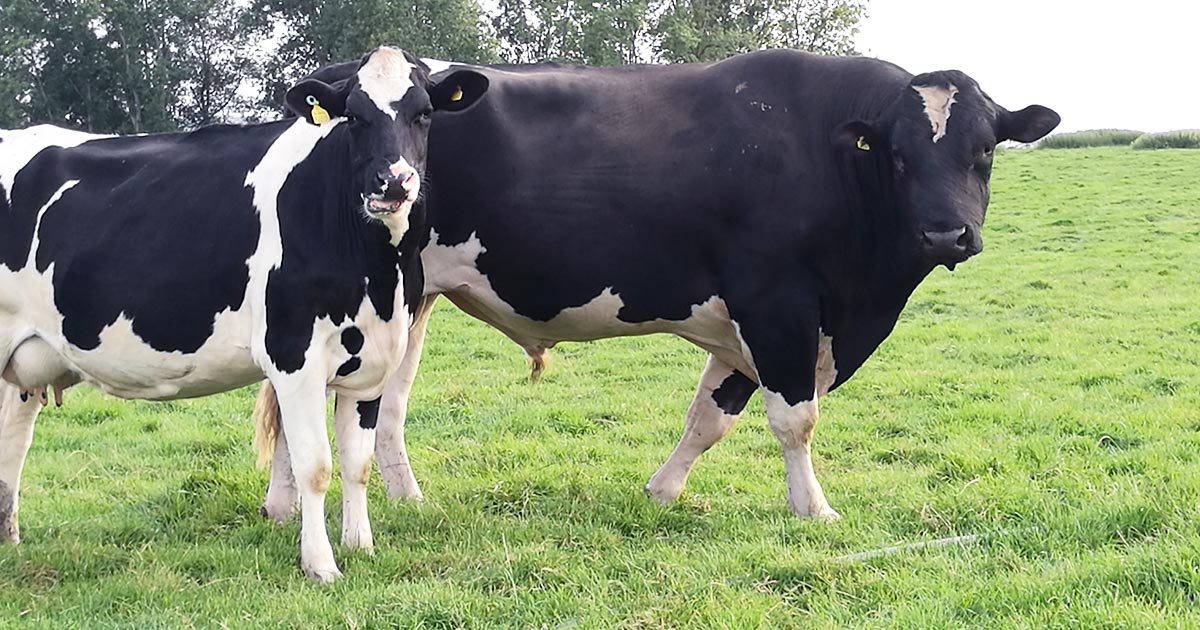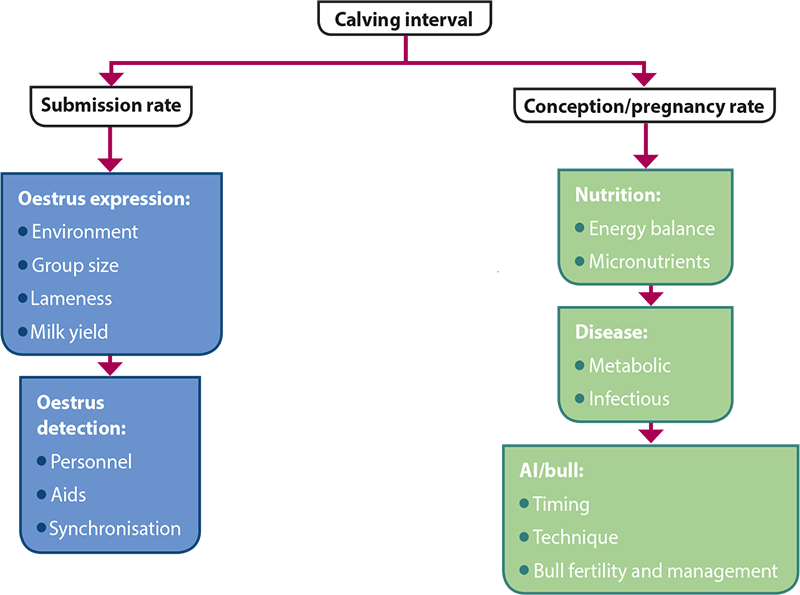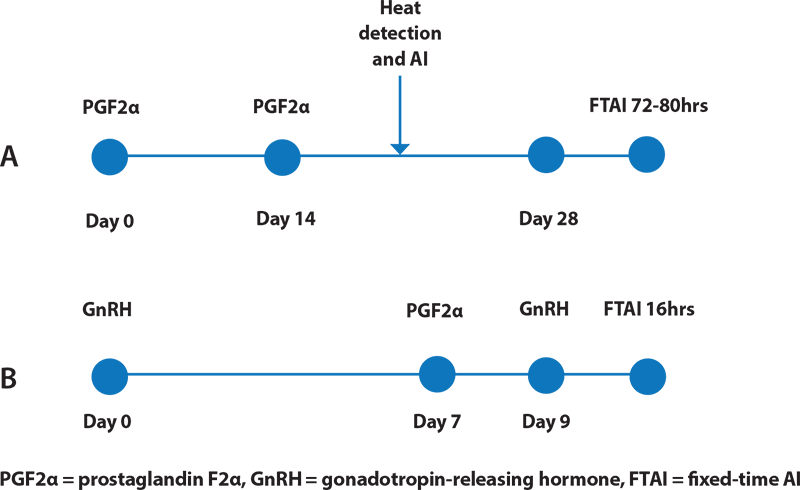12 Feb 2018
Sophie Mahendran looks at how to increase the number of eligible cows served and deal with low pregnancy percentages in herds.

Use of mature dairy bulls for natural service is not common practice in the UK, but when managed correctly, is a good alternative to, or complements, AI.

Successful herd fertility makes up the cornerstone of any profitable dairy enterprise, with many individual components affecting overall key performance indicators achieved.
Some of the economic impact of optimising fertility comes from reducing the time cows spend in late lactation where milk yields are reduced, increasing the number of calves born on farm as they themselves have a high economic value, and reducing the opportunity for cows to become overconditioned, which can predispose to transition and early lactation health problems.
The average UK calving interval is 414 days – a 2-week reduction from the 2009-10 period (Hanks and Kossaibati, 2016) – which hopefully reflects improvements in management strategies both within the farm and veterinary team, but also highlights room for improvement to get the UK average calving interval to less than 400 days.
Generally, the cause of low pregnancy rates can be ascribed to either poor submission rates or poor conception/pregnancy rates – the definitions of which are in Panel 1.
Pregnancy rate
The percentage of serves that result in a pregnancy. This can be calculated for a specific group of animals or over a given time period.
Submission rate
Usually measured in three-week blocks, this gives the percentage of eligible cows that were served. This value is greatly influenced by heat detection.
Conception rate
The number of cows conceiving after a service. It is a function of successful oocyte fertilisation, oocyte implantation and maintenance of the conceptus. However, it does not take into account early embryonic loss and the maintenance of pregnancy; so, on its own, is not a helpful tool.
Twenty-one-day pregnancy rate
The best measure of current and up-to-date fertility efficiency.
21-day pregnancy rate =
submission rate × pregnancy rate
It compares the submission rate over a three-week period and the pregnancy rate over that same three-week period. This is the least retrospective fertility measure, and can be helpful to highlight which area (submission or establishment of pregnancy) may be causing an issue on farm.
Adapted from the Agriculture and Horticulture Development Board Dairy, 2012.
The key component of submission rates are the expression and detection of oestrus behaviour. A cow with a normal oestrous cycle will display overt signs of oestrus, such as standing to be mounted, chin resting and increased activity.
However, this expression of oestrus in modern dairy cows has substantially decreased, with only around 50% of cows standing to be mounted and oestrus signs lasting as short as five hours (Dobson et al, 2008).
Oestrus expression increases in groups where more sexually active cows are present, so use of a fresh cow group or block calving can increase overt oestrus expression. The presence of a bull or a teaser can also increase oestrus expression.
Lameness is another barrier to expression of oestrus, with lame cows taking, on average, 40 more days to become pregnant than non-lame cows (Hernandez et al, 2001) – partly due to a decreased intensity of oestrus signs. In addition to actual lameness, the loafing area and flooring type in buildings can impact oestrus expression due to the confidence cows have in footing affecting their mounting behaviour.
Detection of oestrus is vital for a cow to be submitted for AI. However, it is estimated as many as 50% of oestrus periods go undetected (Stevenson, 2005).
The best oestrus detection systems will allow continuous monitoring of cows, be accurate and efficient, and ideally require minimal labour inputs. Traditional methods of human observation require dedicated time and skill, as well as good communication and recording of data. However, it is often a struggle to achieve this. Use of heat detection aids – such as scratch pad and tail paint – can help with this, but with the increasing time pressures faced by farmers, additional technology may be required.
Pedometers are a relatively modern concept in oestrus detection, and can be located on either the neck or leg. They measure the number of steps taken by a cow in a certain period, and compare this with the expected activity of the cow, with an increase above a certain threshold being indicative of oestrus (Roelofs et al, 2017). Potential problems with these systems are during periods of disturbance to a cow’s routine, such as can be experienced at the start of the grazing season, although Roelofs et al (2017) found no overall significant difference in pedometer performance between indoor and pasture-based cattle.
These systems require the greatest initial monetary investment, but are often found invaluable by farmers who otherwise struggle to spend enough time observing their cows for signs of oestrus.
Hormonal breeding programmes provide another solution to poor oestrus detection by narrowing the window of observation, or even removing it, by using fixed time inseminations. This allows AI to be carried out in a more convenient manor and ensure submission rates are maximised. Multiple programmes and variations are available. The programme used should be selected on a farm-by-farm basis, but overall, Ovsynch is reported to have the greatest pregnancy rates through synchronisation of follicle growth and corpus luteum regression (Stevenson, 2005).
As with most aspects of dairy farming, nutrition is a cornerstone that has far-reaching effects on cattle fertility. Achieving a successful pregnancy is dependent on several different physiological functions. The cow must ovulate a high-quality oocyte, which is then fertilised to produce an embryo.
This, in turn, must trigger maternal recognition to avoid the pregnancy being terminated by a rise in prostaglandins (Roche et al, 2009). In addition to this, the uterine environment must be receptive to implantation, and successful implantation must occur. All these factors can be influenced by historical and current cow energy balance.
The dramatic increase in energy requirement due to rising milk yields up to around eight weeks post-partum are only partially met by increased feed consumption, with the deficit supplied by mobilisation of the cow’s own energy stores.
Body condition scoring (BCS) is a standardised way of assessing the proportion of body fat a cow has, therefore reflecting its stored energy reserves (Roche et al, 2009). Routine recording of cow BCS – especially at dry off, calving and the post-calving check – can help build up a picture of the energy deficits and negative energy balance (NEB) experienced by cows.
Cattle in severe NEB are more likely to have an extended anoestrus period due to delayed resumption of ovarian activity through decreased pulsatile luteinising hormone (LH) secretion, decreased responsiveness to LH and follicle-stimulating hormone, and suppressed follicular oestradiol production (Hills et al, 2015).
In addition, NEB causes an alteration to uterine gene expression, resulting in altered embryonic nourishment, maternal recognition and implantation preparation (Walker et al, 2012). Heat stress can further exacerbate the effects of NEB due to decreased appetites, leading to increased non-esterified acid and urea levels, which have a direct effect on follicular fluid levels, with a retardation of dominant follicle growth and subsequent deterioration of oocyte quality (Shehab-El-Deen et al, 2017). It is outside the scope of this article to go into further detail on transition and early lactation nutrition, but it must be considered when investigating poor dairy cattle fertility.
When dealing with poor pregnancy rates on farm, consideration must be given to presence of infectious disease, with use of appropriate diagnostics required to rule them out.
The main diseases that should be considered are bovine viral diarrhoea (BVD), infectious bovine rhinotracheitis (IBR), Campylobacter fetus subspecies venerealis, Johne’s disease and Neospora. The exact mechanism for reduced fertility varies between pathogens, but BVD virus, for example, is known to impair both oocyte quality and gonadal steroidogenesis (Fray et al, 2000).
Another human factor that must be considered when investigating poor pregnancy rates is the AI technique being employed. For the insemination to take place at the correct time, heat detection must be accurate – premature insemination gives aged sperm that can’t achieve fertilisation by time of ovulation, and late insemination will not provide the sperm enough time for capacitation.
In addition to timing of AI, the handling of the semen must be evaluated for correct storage and thawing. Straws must be removed promptly (within 10 seconds) from the liquid nitrogen tank to avoid continually exposing the semen to variable temperatures.
Semen must then be thawed between 32°C to 35°C for at least 40 seconds, with the straw then used within 10 minutes. Equipment must be clean, with avoidance of disinfectants and soaps, as these can be lethal to sperm, and the AI gun should also be pre-warmed to avoid cold shock to the semen.
This can be easily checked by observation of staff during AI, or a problem may be indicated by analysis of data records showing a particular AI technician having lower pregnancy rates compared to others on farm.


The use of natural service in the UK predominantly focuses on beef bulls, but it is possible to use dairy bulls in both a safe and effective way, if appropriate management strategies are put in place.
The reproductive performance of a bull requires the same elements as humans using AI – the ability to detect cows in oestrus, the ability to effectively mate those cows, and to have sperm that can fertilise the oocyte and produce a viable fetus (Abell et al, 2017). The key difference is bulls are free to concentrate solely on this task, whereas people are usually trying to juggle multiple factors.
A normal fertile bull should get 90% of a group of 50 normal cows pregnant in 9 weeks, with 60% in the first 3 weeks (Green and Bradley, 2012). However, this does require them being fully functioning and fertile. Pre-breeding soundness exams must be used at least annually to ensure bulls are ready to work – this includes a general physical exam, palpation of the genital tract, measurement of the scrotal circumference, and semen collection for motility and morphology assessment.
Management of mature bulls must be carefully considered, with many of the dangerous behaviours exhibited by bulls being due to their poor management.
Bulls are often isolated from the rest of the herd, leading to sexual frustration and unpredictable behaviour. It must be remembered bulls are also herd animals and happiest when kept in stable groups, with consistent daily routines and quiet handling. If this is not achievable on farm, use of bulls should not be considered due to the impact on bull welfare and human safety.
An additional problem with natural service is the potential for venereal disease spread. Important diseases include Campylobacter, Trichomonas fetus, Mycoplasma, BVD and IBR. All bought-in bulls should undergo quarantine and appropriate disease screening to reduce the risk of introduction of these diseases into a herd.
Obtaining and maintaining high levels of dairy cow fertility should be a priority on all successful dairy farms. Having a clear understanding of all the separate components that impact fertility is key to solving fertility problems, with the root cause differing from one dairy enterprise to another.
The first step, in any investigation, is to identify the problem area – either submission or conception/pregnancy rates – and from there, narrow down and address appropriate causes.